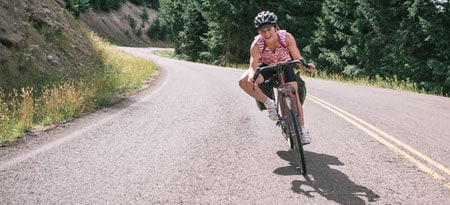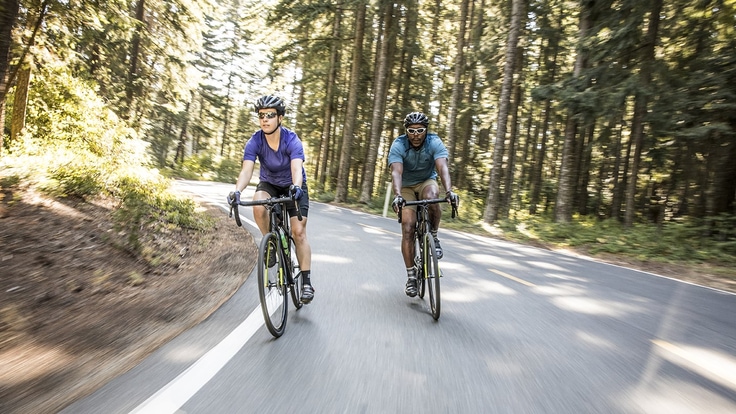All the elements of good technique come into play when climbing and descending hills on your road bike. Maintaining good balance, both fore-and-aft and side-to-side, while staying mentally tough on the climb and knowing when to brake on the descent — and when not to — are all key to success.
Also, before you head out for your ride, remember to do your pre-ride inspection.
Climbing Hills on a Road Bike
Assuming conditions are good — meaning you have traction — climbing on a road bike is a matter of getting the most power for the energy you spend.
Body Position for Climbing Hills

Seated: When possible, keep your rear end on the seat and keep your pedaling cadence high. This assures a maximum transfer of your energy into power. The most efficient cadence, or pedaling rate, is between 70 to 90 revolutions per minute. If you need more power:
- Drive your rear end to the back of your seat as you push on the downstroke.
- Lean forward.
- Keep your elbows flexed but pull on the handlebar opposite from your downstroke leg. This helps you use your gluteal muscles as well as your leg muscles.
Standing: Sometimes the hills get very steep and you need even more power than sitting allows.
- As you begin the downward stroke, lean the bike away from the foot delivering the stroke.
- Keep your body in a straight line over the weighted foot.
- Lean forward on the handlebars to deliver even more power, but keep your elbows loose.
- As the weighted foot finishes its stroke, transfer your weight to the other foot.
- Use the bike as a lever to help pull your weight over to the other foot. The bike should now be leaning toward the unweighted foot and your body should be in a straight line above the weighted foot.
Pedaling Technique for Climbing Hills
Scraping motion: When your foot is at the bottom of the pedal stroke, move the foot back as if you're scraping mud or gum off the sole of your shoe. Then pull up on the pedal and step forward until that foot is ready to deliver another stroke.
Practice: Pedal with just one foot and try to get the push-scrape-pull-step motion down so that you're delivering a smooth circle full of power. Do this a hundred times.
Now do it with the other leg. Once you feel comfortable doing this with each leg individually, start using them both to climb that hill.
Shifting While Climbing Hills
Timely shifting is key to your success when climbing a hill. If you shift too soon, you'll lose all your momentum. Shift too late and you'll struggle to get up the hill.
- Keep your cadence consistent throughout a climb.
- As soon as your cadence starts to slow, shift into an easier gear.
- For smooth shifting, ease up on the pedals while shifting to take the pressure off the chain.
What gear to use? What gear you climb a hill in depends on the steepness of the hill and your fitness level. Stronger, fitter bikers can climb a hill in a higher gear while keeping their cadence up. Beginner cyclists will likely end up in the lowest gear more frequently.
Avoid cross-chaining: Whatever gear combination you use, make sure the chain isn't being stretched diagonally. For instance, avoid being on the largest chainring in the front and largest gear in back (or smallest to smallest). This approach encourages a longer chainring life.
Mental Approach to Climbing Hills
In addition to proper bike technique, most good climbers learn how to trick themselves into staying in the saddle longer or standing longer when needed. Try mentally taking the hill in sections: "All I have to do is make it to that tree up there." Then, take another section, and another until you picture yourself making it to the top.
Descending Hills on a Road Bike

Going downhill on a road bike is a combination of comfort level, knowing what your bike can handle and using a few standard techniques to keep you riding securely and confidently.
Body Position While Descending Hills
The steeper the hill, the more your weight should be back on the saddle. Pressure on the rear wheel helps with braking and with cornering.
For straight downhills:
- Get low and aerodynamic.
- Make sure your grip is relaxed and keep your hands on the drops near the brakes.
- Bend your elbows and keep them tucked in toward your sides.
- Raising your rear end slightly out of the saddle can help improve your balance.
- Assuming 12 o'clock is at the top of the pedal stroke, your feet should be at the 3 and 9 o'clock position — this is your platform. From here you are centered on your bike and well balanced.
When cornering:
- Drive down the outside leg and lean on the inside drop.
- If you need to throw a knee out, that's fine, but keep your outside elbow in close and your head and shoulders level. This will help ensure your tires stay in contact with the road.
Braking While Descending Hills

When descending on a road bike, keep the pressure light, move your weight back and apply both brakes evenly.
Hit the brakes too hard when you encounter a patch of gravel or a larger obstacle and you could end up in a crash. If you do have time to brake:
- Send your weight back, but when you reach the rough section, move your weight forward and make sure your feet are in the 3 and 9 o'clock platform position.
- Keep a firm but relaxed grip on the bars so you can absorb shock.
- Lighten up on the brakes once you're in the area of poor traction.
- Think light and imagine floating over the rough section of road. Resist the urge to put a foot out for stability.
- Scrub speed if you need to after the sand or gravel is safely behind you.
If you can't avoid the debris in your path, the best you can do is a slight bunnyhop (if you feel comfortable doing bunnyhops), or to run the debris over.
Either way, a relaxed grip and coming up slightly out of the saddle will help.
(If the debris does cause you to crash, remember to stay loose and roll with the crash. Putting your hands out will cause more harm than good.)
